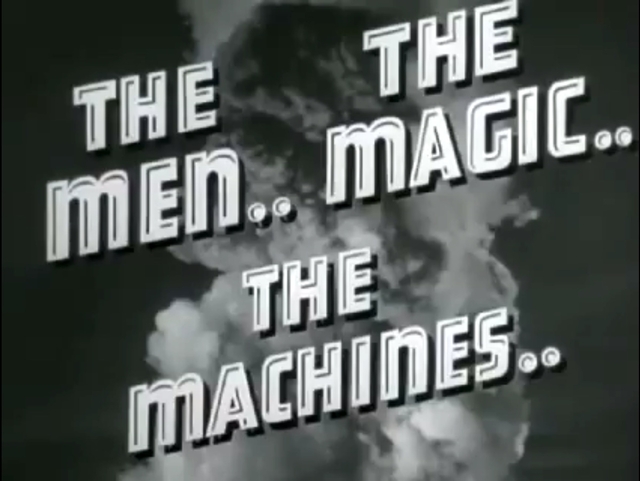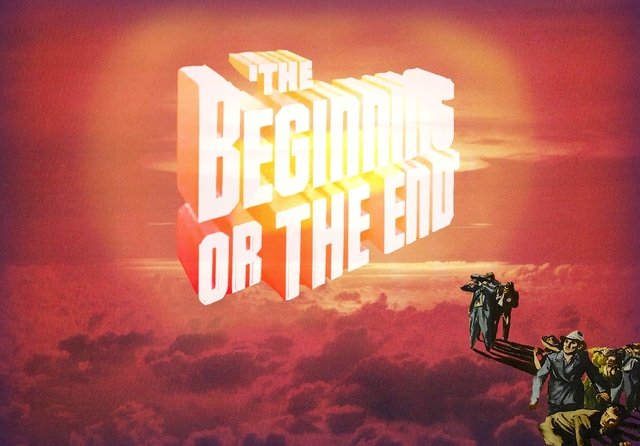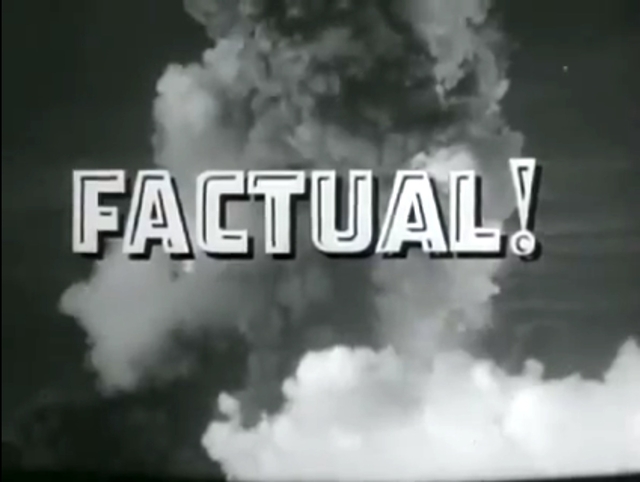Box Office Bomb: “The Beginning or the End” (1947)
In the years after 1945, apocalyptic visions of the end of the world were closely bound up with the specter of nuclear weapons. The world, it seemed, would end not with a whimper, but a bang. Nuclear fears pervaded popular culture in the 1950s and 1960s, notably in such films as “Them!” (1954), in which atomic tests turn ordinary ants into giant monsters, “Godzilla” (1954), in which atomic tests turn a giant monster into an angry giant monster, and “Dr. Strangelove” (1964), in which a rogue general sets off a global thermonuclear war.
The first major nuclear film was a bit different. Released by MGM in 1947, “The Beginning or the End” presented a dramatized account of the Manhattan Project that produced the first atomic bombs, packaged along with a rather wooden love story and some moralizing messages about the significance of the new nuclear era. Although it was heavily promoted, and in fact received an Oscar for its special effects, the film was neither a critical nor a commercial success; it was in many ways a ‘bomb’ itself.
But while “The Beginning or the End” has been largely forgotten except by students of nuclear culture, the story of its making still has much to tell us about early attitudes toward the atomic bomb, and especially about how different groups sought to shape those attitudes.
The movie got its start in a curious way. Just after the end of the war, the actress Donna Reed learned that her former Iowa chemistry teacher, Edward R. Tompkins, had worked on the Manhattan Project at Oak Ridge, Tennessee. She wrote to thank him for his service, and he wrote back with a movie pitch. Tompkins had become active in the Association of Oak Ridge Scientists, part of the “scientists’ movement” that aimed at educating the public about the dangers of nuclear weapons and shaping government policy on their control. He told Reed that he and other members of the movement thought a Hollywood movie would provide an excellent way to get their message across to the broadest possible audience. What could be more dramatic than the story of teams of scientists working in secret to produce bombs that could destroy the world? And what could bring the dangers of possible nuclear annihilation home to the public more vividly than a well-crafted feature film?

The film’s creators billed it as “the personalized drama of the men and women who bent to their will the forces of the atom bomb.”
As it happened, Reed’s husband, Tony Owen, was a movie producer and agent, and he soon managed to interest MGM producer Sam Marx in the project. Hoping to secure government cooperation, Marx and Tompkins traveled to Washington and met with top officials, including President Harry Truman. Truman reportedly told them he hoped they would make their film and use it to “tell the men and women of the world that they are at the beginning or the end.” Marx replied, “Mr. President, you’ve given us our title!” and the project seemed well under way.
Early drafts of the screenplay followed the line laid out by Tompkins and others in the scientists’ movement, emphasizing the horrors of nuclear war and, in a climactic scene, depicting burned bodies in the ruins of Hiroshima. But the script went through many revisions as different groups and individuals vied to shape its message. A law then in force required a studio to obtain a signed release from any living person it wished to depict in a movie, and various figures who had been involved in the atomic bomb story used the ensuing negotiations to try to influence the tone and content of the screenplay. Some scientists, notably Niels Bohr, simply refused to cooperate with what they thought would inevitably be a shallow and distorted treatment of historic events, and they were dropped from the story. J. Robert Oppenheimer (played by Hume Cronyn) shared this distaste—the characters, he said, seemed “stilted, lifeless, and without purpose or insight”—but, pressured by the studio, reluctantly signed his release. Leo Szilard, the Hungarian-born physicist who had done as much as anyone to launch the effort to build atomic bombs, and then strove mightily to prevent their use on Japan, signed as well, though he later regretted it. MGM was especially eager to land Albert Einstein. Studio head Louis B. Mayer tried to assuage his concern that the script distorted the historical record by explaining that “dramatic truth is just as compelling a requirement on us as veritable truth is on a scientist.”
Mayer never explained exactly what he meant by “dramatic truth,” but it evidently involved sticking close enough to Hollywood formulas to ensure the film would be able to pull in a paying crowd. In any event, Einstein eventually signed his release, though he already feared that the film was heading in a direction quite different from that first envisioned by Tompkins and his colleagues in the scientists’ movement.
Three key figures in this redirection of the film were Vannevar Bush and James B. Conant, the directors of all wartime military research, and General Leslie R. Groves, the head of the Manhattan Project itself. Bush and Conant had been skeptical of the film project from the first, fearing on the one hand that a Hollywood treatment would trivialize serious national issues, and on the other that a film inspired by members of the scientists’ movement might turn American public opinion against nuclear weapons, as the public had turned against chemical weapons after World War I. A rejection of the legitimacy of nuclear weapons would, they feared, effectively deprive the United States of the strongest part of its arsenal at a time when it faced increasing tensions with the Soviet Union. Bush and Conant used the negotiations over the signing of their releases to push for a more positive (and, as they saw it, more historically accurate) portrayal of the project and its leaders, and they had some success.
General Groves was even more directly involved with the film. Seeming to relish the prospect of being portrayed on the big screen, he worked closely with filmmakers and advised them on many aspects of the story. In fact, unbeknownst to the scientists involved, Groves persuaded MGM to hire him as a special consultant on the film, pay him the then princely sum of $10,000, and give him final script approval. By the time director Norman Taurog was ready to start shooting, the revised screenplay depicted the atomic bomb project as a great American success story; in Sam Marx’s words, it was nothing less than “the most magnificent triumph of modern times.” The ultimate destruction of Hiroshima—now seen only from afar, through clouds of smoke—was portrayed as simply a regrettable necessity. Perhaps not surprisingly, Groves (played by Brian Donlevy, with top billing) came across as the dashing hero of the story.
One scene in the movie proved particularly contentious. As originally shot, it showed Groves and Secretary of War Henry Stimson briefing Truman not long after he assumed the presidency. On being told of the existence of the Manhattan Project, he made what appeared to be a snap decision to approve dropping atomic bombs on Japan as soon as they were ready to go, declaring, “I think more of our American boys than I do of all our enemies.”
When MGM showed him a preview of the film, Truman was uneasy; he did not want moviegoers to get the impression he had made such a momentous decision without considering all the ramifications. Not wanting to be accused of censorship, he raised no official objection but people around him, led by columnist Walter Lippmann, loudly demanded that MGM make changes. The decision to drop the bombs had been reached only after thorough consideration, they claimed, and the movie should not make it look like Truman made it flippantly.
MGM relented and shot a new scene, now showing Truman at the Potsdam Conference in Germany telling an aide in portentous terms about how carefully he had weighed the decision. Deeply impressed, the aide said, “You must have spent many sleepless nights over it.”
In fact there is no evidence that any such thing ever happened. In later years Truman always denied that he lost any sleep over the decision to drop the atomic bombs, and the best evidence indicates that he scarcely made a real decision at all. That atomic bombs would be dropped on Japanese cities as soon as they were ready had long been treated as a foregone conclusion among the leaders of the Manhattan Project, and the most that can really be said of Truman’s “decision” is that he did not intervene to stop or redirect a process that was well underway even before he became president.
But Lippmann was not really concerned with fidelity to the historical record; his concern focused neither on veritable truth nor on dramatic truth, but on what we might call political truth, or at least on telling a politically useful story, calculated to reassure the people of the world that America’s leaders took their atomic responsibilities seriously. MGM delivered just that in the reshot scene, with the fictional Truman now declaring that he decided to approve dropping the bombs only after careful studies showed that their use would end the war at least a year earlier and save the lives of nearly half a million American soldiers.
But again, little trace of such estimates can be found in documents from the summer of 1945. Once the war was over, however, they quickly became a standard part of the official justifications offered for dropping the bombs, and their inclusion in the film reinforced the impression that such considerations had guided Truman’s decision. Moreover, the fictional Truman told his aide that the atomic bombs would be used only on “prime military targets,” and only after leaflets had been dropped to warn Japanese civilians to evacuate. Both statements were quite false; the bombs were in fact dropped without warning on cities full of civilians.
“The Beginning or the End” played fast and loose with the facts on other points as well, presumably in the pursuit of “dramatic truth.” Much of the story centered on the wholly fictional character of Matt Cochran (played by Tom Drake), an idealistic young Manhattan Project scientist. In one of the climactic scenes, Cochran is shown assembling the bomb on Tinian in the Pacific when something slips. He reaches in to grab the part, and while he manages to keep the bomb from exploding and killing thousands on the island, in doing so he absorbs a lethal dose of radiation. When a friend comes to help him, Cochran ruefully says, “Maybe that’s what I get for helping to build this thing,” but any hint that the bomb is an evil thing whose builders must somehow atone is quickly swept under the rug. Cochran lingers long enough to ask his friend to deliver a final letter to his now pregnant wife, and in a schmaltzy ending, his ghostly figure reads out the letter, extolling the wonders of atomic energy and implying that his sacrifice may be the means to bring a brighter day to all of humanity.
It was classic Hollywood claptrap, and virtually the opposite of what Tompkins had hoped for when he first wrote to Donna Reed. Leo Szilard summed up the bitter disappointment of many of his colleagues when he said that “If our sin as scientists was to make and use the atomic bomb, our punishment was to watch ‘The Beginning or the End.’”
Right up to its gala premiere in February 1947, MGM executives apparently thought “The Beginning or the End” was destined to be a huge hit. They sent out an elaborate press kit explaining how the movie came to fruition, and produced a bizarre promotional trailer (see supernote at right) featuring an “inquiring reporter” talking about the importance of the film and its subject with people streaming out of a preview showing. But it was easy to see that it was all staged and the gushing “audience members” were actors; real audiences mostly stayed away. After a brief run in theaters, “The Beginning or the End” virtually disappeared from view; audiences appeared to have little taste for its preachy tone and wooden performances. To this day, the film has never been released on video. It turns up occasionally on the Turner Classic Movies cable channel, giving us a brief glimpse back at the beginnings of the nuclear era—through the fictionalized story the movie tells, and perhaps more revealingly in the real story of the movie itself.



